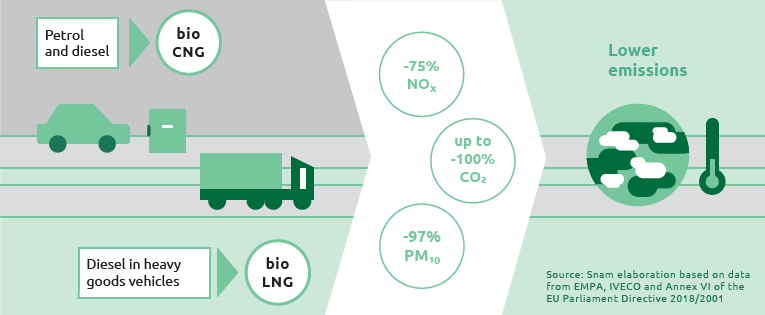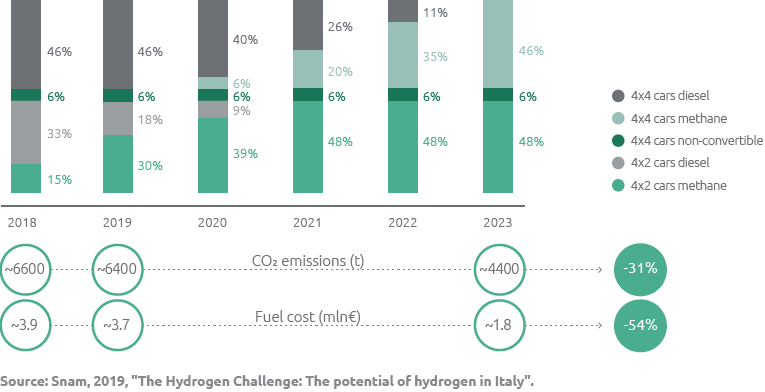Managing the energy of the future: the sustainable mobility
The deployment of natural gas in the transport sector and the integration of biogas and biomethane will play a crucial role in supporting domestic economic growth and in combating climate change, in a process of rapid global transition towards decarbonised economies. The ease of transporting and storing natural gas allows the development of multiple projects linked to the widespread use of compressed natural gas (CNG) for motor transport and liquefied natural gas (LNG) used in heavy land and sea transport. In addition, biomethane can also be compressed, liquefied, transported and used like renewable fuel. Alongside the development of low emission fuels, the commitment outlined in its Strategic Plan means that Snam will upgrade the existing infrastructure in order to expand the network of natural gas refuelling stations. This objective will also be achieved through targeted partnerships with other sector players, such as the acquisition of Cubogas, involved in the business of natural gas compressors for sustainable mobility.
Compressed natural gas (CNG) for motor transport: an effective response to transport generated pollution
The natural gas transported in the Snam network can be compressed and used as an alternative to traditional fossil fuels for cars, lorries and buses. The use of CNG instead of petrol and diesel has significant environmental advantages: compared with traditional fuels, CNG allows the reduction of CO2 emissions by around 20% (and up 100% if from biomethane), nitrogen oxides by around 75% and fine particles by 97%. Strengthened by its extensive pipeline network, which allows the transportation of CNG with little impact on the environment and vehicular traffic, Italy is already the market leader in Europe for the consumption of methane for motor traffic, with over a billion cubic metres consumed in 2019 and around one million vehicles currently in circulation.
During the year, Snam ratified agreements and partnerships with the aim of promoting sustainable mobility throughout the country.
In 2019, Snam and the Spanish motor manufacturer SEAT worked together since the agreement signed in 2018 for the technological development and expansion of compressed natural gas and biogas refuelling infrastructure for sustainable development. This partnership involved Snam’s commitment to creating innovative infrastructures and the development, by SEAT, of new models of vehicles running on methane. The companies worked on development opportunities for initiatives aimed at retailers, commercial customers and motorists to promote the network of natural gas refuelling stations and identify initiatives for the technological development of biomethane. Specifically, commissioned by the competent Ministries, Snam produced a web tutorial for the implementation of the self-service facilities dedicated to natural gas for motor transport. This new partnership will develop further the sustainable mobility with natural gas and biomethane, both in Italy and throughout the continent, because it joins together two European leaders: Snam in the creation of innovative infrastructures and SEAT in the development of new sustainable models.
As part of the promotion of sustainable development in Italy, in 2019 Snam upgraded the existing infrastructure in readiness for the development of the CNG and LNG markets.
Alternative to traditional fuels: bio CNG and bio LNG

In 2019, Snam introduced
360
methane powered
cars
to its company fleet, to replace diesel ones
In order to expand the network of refuelling stations for vehicles running on natural gas, in 2019 the Company concluded an agreement with the IP Group for 25 roadside and motorway stations. Through its subsidiary Snam4Mobility, since 2017 it has signed agreements with various counterparties for the development of more than 100 refuelling stations, 11 of which are for LNG with compression systems for gas produced by the subsidiary Cubogas. Snam’s goal is to create over 250 new distributors on a national scale, which will be part of the network already developed in Italy, to better balance the deployment in the different regions of the country.
The conversion of the company’s fleet of vehicles to natural gas continued, increasing the number of new vehicles running on methane in 2019 by more than 360 (out of a total of 520 compared with 142 in 2018) in preference to diesel vehicles.
All motor vehicles purchased are defined as monofuel, which means that the petrol tank is extremely small, with a capacity of only 9 litres. This was an important tool in the daily use of methane, in preference to petrol.
In addition, a small refuelling station was installed by the subsidiary Cubogas in 2019 with a compressor for the company’s methane vehicles at Snam’s headquarters in San Donato Milanese and many more will follow at other company premises throughout Italy. This compressor comes under the category of domestic systems, that allow the refuelling of vehicles directly, at home or at work. It involves reasonably small systems that are simple to install, that can be adapted to the low-pressure domestic gas network or the 220w electricity grid and are therefore ideal for refuelling the fleets of companies or small municipalities.
Expected development of cars in circulation

Liquefied natural gas (LNG): a solution for reducing maritime and heavy transport emissions
LNG is produced from natural gas that is cooled and compressed until it reaches a liquid state. In this form the gas can be easily stored and transported, and importing it by sea allows for further diversification of procurement sources, with positive effects on national energy security.
LNG can be consumed in traditional systems or as an alternative to other fossil fuels for motor transport, rail transport or sea transport, replacing diesel, fuel oil or marine diesel.
The use of LNG instead of diesel has significant environmental advantages with a considerable reduction in emissions both in terms of climate altering gases and local pollutants, especially in the case of the use of LNG from methane produced from renewable sources. Specifically, the use of liquefied natural gas allows a reduction in emissions of fine particles (-97%), nitrogen oxides (-75%) and CO2 (up to 100% in the case of the use of BioLNG).
For these reasons, in 2019 Snam developed numerous initiatives with its partners for the development of small scale infrastructures with the aim of promoting the production and distribution of liquid natural gas to advocate sustainable mobility for ship, lorry and train transportation. Specifically, Snam completed the upgrading of the Panigaglia terminal in order to allow the unloading of lorries for the distribution of LNG and developed further activities concerning micro-liquefaction plants. These activities come under the principles described in the DAFI (Law 257/2016) in order to develop and increase the use of alternative fuels throughout Italy).
In 2019 Snam also signed a Memorandum of Understanding with the FS Foundation and HITACHI for research into and the operational implementation of the first LNG train in Italy. This collaboration is the result of the desire of 3 companies to also transform the railway industry (traditionally electric or diesel) into a new “customer” for methane also promoting the use of green fuels to replace diesel. The end of the project is the first inaugural journey on the tourist lines run by the FS Foundation expected to take place by the end of 2020 after the conversion of the diesel engines and tanks to liquefied natural gas.